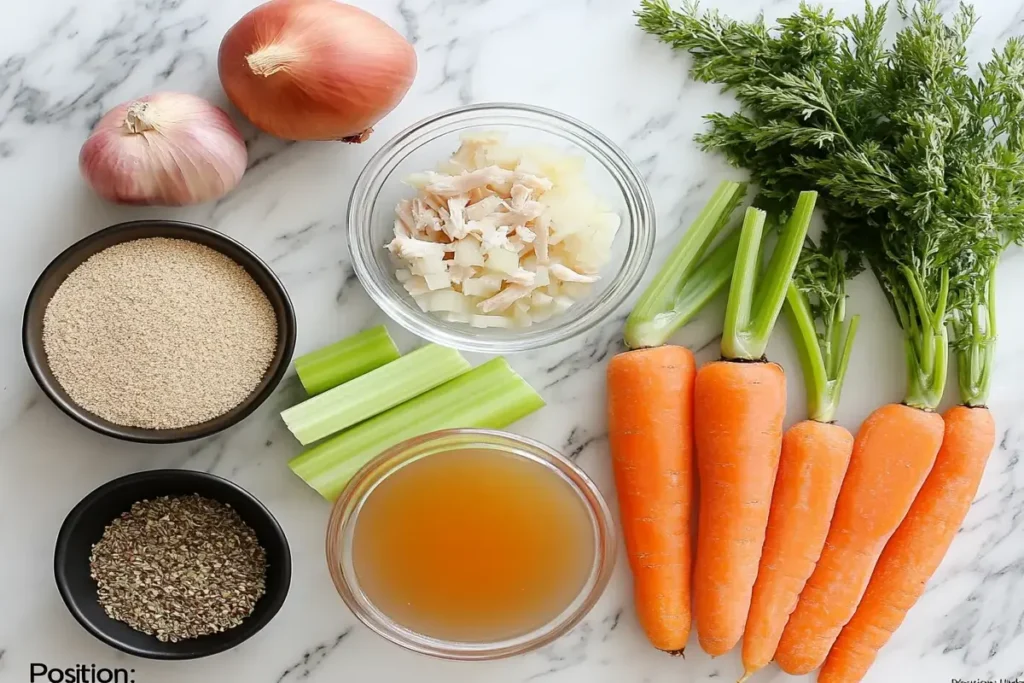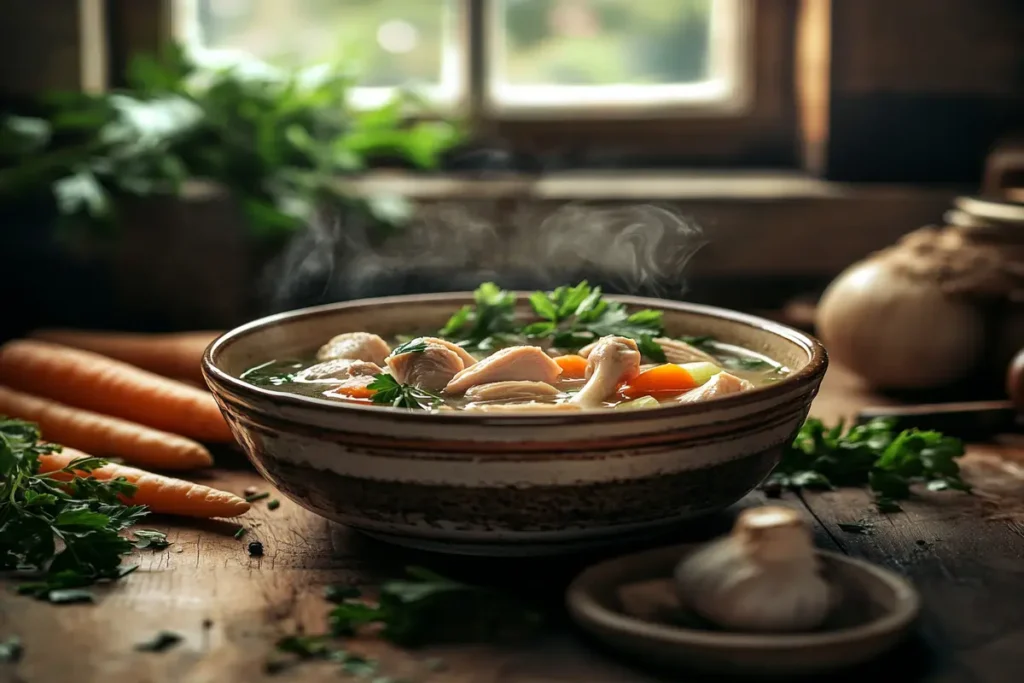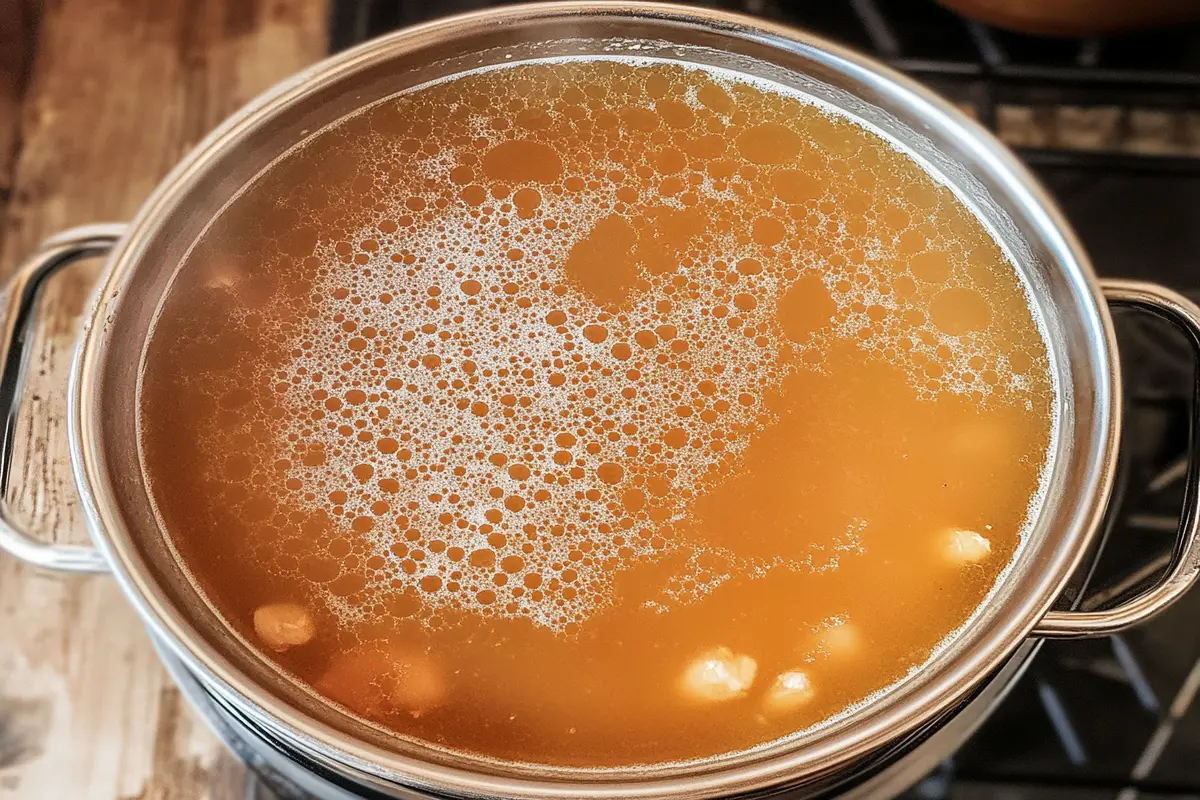Chicken bone broth has earned its reputation as a culinary powerhouse and health elixir. Packed with nutrients, collagen, and a host of beneficial compounds, this humble dish is much more than a comforting soup base. From its ancient roots to its modern-day popularity, bone broth offers a flavorful, wholesome addition to meals and wellness routines. This guide dives deep into everything you need to know about creating the ultimate chicken bone broth recipe. Whether you’re a first-timer or an experienced cook, this guide has you covered.
What is Chicken Bone Broth?
Definition and Key Characteristics
At its core, chicken bone broth is a nutrient-dense liquid made by simmering chicken bones, connective tissues, and vegetables over a long period. Unlike stock, which is cooked for hours, bone broth is simmered for an extended period—often 12 to 24 hours—to extract maximum nutrients. The result? A rich, flavorful broth that’s as healthy as it is delicious.
Bone broth stands out for its gelatinous texture when cooled, thanks to the high levels of collagen and amino acids released during the cooking process. It’s also characterized by its deep golden color and robust flavor, making it a favorite for soups, sauces, and even as a stand-alone drink.
The Historical Roots of Bone Broth
The history of bone broth dates back centuries, spanning cultures around the world. From Chinese herbal soups to European bouillons, people have long relied on this nutrient-rich broth for its flavor and health benefits. Traditional recipes often included medicinal herbs, further emphasizing its healing properties.
Why Chicken Bone Broth is Popular Today
In recent years, chicken bone broth has enjoyed a resurgence, thanks to the growing interest in gut health and natural remedies. Its versatility is another reason for its popularity—you can sip it as a warm drink, use it as a base for meals, or freeze it for future use. Plus, the rise of diets like keto and paleo has spotlighted bone broth for its low-carb, high-protein profile.
Health Benefits of Chicken Bone Broth
Nutritional Profile: Vitamins, Minerals, and Collagen
The chicken bone broth recipe isn’t just a flavorful kitchen staple—it’s a nutritional powerhouse. This broth is rich in essential minerals like calcium, magnesium, and potassium, which support strong bones and healthy muscles. Packed with collagen, it also helps maintain the elasticity and strength of your skin, hair, and nails. Additionally, amino acids such as proline and glycine promote tissue repair and overall wellness.
One serving of bone broth provides an easy, low-calorie way to boost your daily intake of vital nutrients. Whether you’re following a wellness-focused diet or simply looking for a comforting, wholesome drink, this recipe is a perfect fit.
Gut Health and Immunity Boosting Properties
Looking to improve digestion or fortify your immune system? Chicken bone broth may be the answer. The gelatin in bone broth helps seal the gut lining, reducing inflammation and supporting better nutrient absorption. Plus, the minerals and compounds it contains are known to bolster your body’s natural defenses, making it a great choice during cold and flu season.
Drinking warm broth also soothes sore throats and provides hydration, further enhancing its reputation as a healing remedy.
Skin, Joint, and Bone Health Benefits
Collagen from the broth contributes to improved joint health by supporting cartilage regeneration. Over time, regular consumption can help ease joint discomfort and improve mobility. For those focused on skincare, the natural collagen boost aids in maintaining a youthful glow by reducing wrinkles and promoting elasticity.
Ingredients for Chicken Bone Broth
Essential Ingredients for a Flavorful Broth

To make the best chicken bone broth recipe, start with high-quality ingredients. Use chicken bones, either raw or roasted, as the foundation of your broth. Roasting the bones beforehand deepens the flavor and creates a richer, golden color. Add onions, carrots, and celery to create a traditional mirepoix, which forms the base for the broth’s aroma and taste.
Don’t forget a splash of apple cider vinegar—it helps extract the minerals from the bones during simmering. A few sprigs of thyme, parsley, and a couple of bay leaves round out the flavor profile beautifully.
Optional Add-Ins for Enhanced Nutrition
Want to take your broth to the next level? Add superfoods like turmeric for its anti-inflammatory properties or ginger for added warmth and digestive support. A clove or two of garlic not only enhances flavor but also provides a natural immunity boost. For a spicy kick, toss in a pinch of red pepper flakes.
Tips for Selecting the Best Bones
The quality of your bones matters! Opt for free-range, organic chicken bones whenever possible. These provide the most nutrients and ensure a cleaner, healthier broth. Save scraps from roasted chickens or purchase bones from a trusted butcher for an economical and sustainable choice.
Step-by-Step Cooking Instructions
Preparing the Bones and Vegetables

Making a delicious chicken bone broth recipe begins with preparation. Start by rinsing your chicken bones thoroughly under cold water to remove impurities. For added flavor, roast the bones in a 400°F oven for about 20–30 minutes until golden brown. This step enhances the broth’s depth and richness.
Next, chop onions, carrots, and celery into large chunks—no need for precise cuts since they’ll simmer for hours. Gather herbs like thyme and parsley, and have your apple cider vinegar ready. This vinegar is crucial as it helps break down the bones, extracting nutrients and flavor.
Stovetop, Slow Cooker, and Instant Pot Methods
- Stovetop: Add the prepared bones, vegetables, and herbs to a large stockpot. Cover with water and bring to a gentle boil. Skim off any foam that rises to the surface. Reduce to a low simmer, cover partially, and let it cook for 12–24 hours.
- Slow Cooker: For a hands-off approach, transfer all ingredients to a slow cooker. Cover with water, set to low, and simmer for 24 hours. This method extracts every ounce of goodness without constant monitoring.
- Instant Pot: Short on time? Use an Instant Pot. Add the ingredients, set the pot to high pressure, and cook for 2–4 hours. This method delivers a nutrient-rich broth quickly while preserving its full-bodied flavor.
How to Achieve a Clear, Rich Broth
Clarity matters when crafting the perfect chicken bone broth recipe. Avoid rapid boiling, which can cloud the broth. Instead, maintain a slow simmer. To strain, use a fine-mesh sieve or cheesecloth to catch small particles. For even clearer results, strain it a second time.
If you’d like more comfort food ideas, check out Chicken Pot Pie Recipe.
Variations and Customizations
Herb-Infused Bone Broth for Extra Flavor
Elevate your chicken bone broth recipe with additional herbs. Experiment with rosemary, sage, or even dill for a unique flavor twist. Add them during the last hour of simmering to keep their aromas fresh and vibrant.
Spicy Bone Broth for a Warming Kick
Love a bit of heat? Add sliced jalapeños or crushed red pepper flakes to your broth. A touch of smoked paprika or cayenne pepper can also bring a smoky, spicy kick that pairs wonderfully with winter soups.
Bone Broth with Added Superfoods
Boost the nutritional value of your broth by adding superfoods like seaweed, shiitake mushrooms, or even a splash of coconut milk for creaminess. These ingredients not only enhance the flavor but also provide extra health benefits, making your broth even more powerful.
Storing and Using Chicken Bone Broth
Best Practices for Storing
Once your chicken bone broth recipe is complete, proper storage ensures its freshness and quality. Allow the broth to cool to room temperature before transferring it to containers. Use glass jars, airtight containers, or freezer bags depending on your storage preferences.
For refrigeration, store the broth in sealed containers for up to 5 days. If you plan to keep it longer, freezing is your best option. Freeze broth in ice cube trays for convenient, single-serving portions, or use larger containers for bulk storage. Label containers with the date to avoid confusion.
Using Broth in Recipes
A good chicken bone broth recipe isn’t just for sipping! Incorporate it into your meals as a base for soups, stews, or risottos. It’s perfect for enhancing sauces or deglazing pans after cooking meats. For a light and refreshing dish, use bone broth instead of water when cooking grains like quinoa or rice.
Feeling adventurous? Replace water with bone broth in savory baking recipes like pot pie crusts or savory muffins for an added depth of flavor.
Freezing for Long-Term Use
To freeze your broth efficiently, portion it into freezer-safe bags and lay them flat in the freezer to save space. Alternatively, freeze broth in silicone molds for easy pop-out servings. Frozen broth can last up to 6 months without losing its flavor or nutritional benefits.
FAQs About Chicken Bone Broth
How Long Should I Cook Bone Broth?
Cooking times vary based on your method. For stovetop and slow cooker methods, aim for 12–24 hours to extract maximum nutrients. Instant Pots cut this down to just 2–4 hours while still delivering a nutrient-rich broth.
Can I Reuse Bones?
Yes! Bones can be reused once, but the flavor and nutrients will diminish. If you choose to reuse them, combine fresh bones with previously used ones to maintain the richness of your chicken bone broth recipe.
What Are the Best Vegetables to Add?
Stick to classic vegetables like carrots, celery, and onions for a balanced flavor. For a sweeter broth, add parsnips or leeks. Avoid starchy vegetables like potatoes, as they can cloud the broth and alter its texture.
Can I Make Bone Broth Without a Slow Cooker or Instant Pot?
Absolutely! A large stockpot on the stovetop works perfectly. The key is to maintain a gentle simmer and skim impurities regularly for a clear broth.
Frequently Asked Questions (FAQs) About Chicken Bone Broth
Is Chicken Bone Broth Better Than Beef Bone Broth?
The answer depends on your preference and intended use. Chicken bone broth recipes produce a lighter, milder flavor, making them versatile for soups, stews, and sipping. Beef bone broth, on the other hand, has a richer and deeper taste, ideal for heartier dishes. Both are nutrient-dense and beneficial, so it’s worth trying both to see which suits your needs.
How Often Should I Drink Bone Broth for Health Benefits?
For optimal results, aim to drink one cup per day. Incorporating chicken bone broth into your routine can support gut health, skin elasticity, and joint strength. If daily consumption isn’t practical, having it a few times a week still provides valuable nutrients.
What Is the Difference Between Bone Broth and Stock?
Though similar, stock and bone broth differ in cooking time and nutrient content. Stock typically cooks for 4–6 hours, extracting flavor but fewer nutrients. Bone broth simmers for 12–24 hours, maximizing the release of collagen, gelatin, and minerals.
Why Is Apple Cider Vinegar Used in Bone Broth Recipes?
Apple cider vinegar helps break down the bones during cooking, releasing nutrients like calcium and magnesium into the broth. It also enhances the overall flavor of the chicken bone broth recipe, creating a more well-rounded profile.
Conclusion and Final Thoughts
Crafting the perfect chicken bone broth recipe is easier than it seems, and the results are well worth the effort. Whether you’re making broth to sip on a cold day, as a base for a hearty soup, or for its impressive health benefits, this versatile dish is a must-have in any kitchen. By choosing high-quality ingredients and following tried-and-true techniques, you can create a nutrient-packed broth that’s as delicious as it is nourishing.
From selecting the right bones to exploring creative variations, this guide has provided all the tools you need to master the art of bone broth. Remember, the beauty of this recipe lies in its adaptability—feel free to tweak it to suit your taste and dietary needs. And don’t forget the countless ways to use it, from cooking grains to enhancing sauces.
Ready to give it a try? Gather your ingredients, choose your preferred cooking method, and let the magic begin. Your homemade chicken bone broth recipe awaits, promising warmth, flavor, and countless health benefits in every sip.

